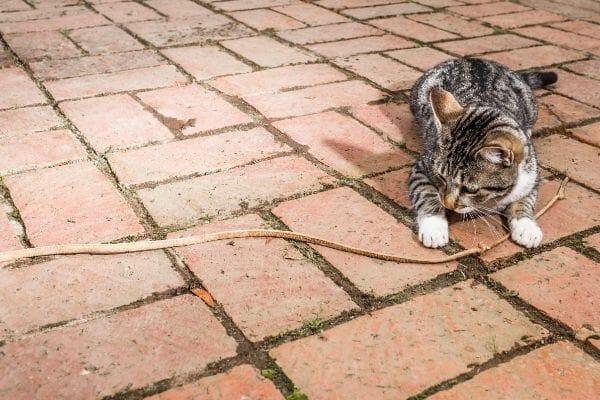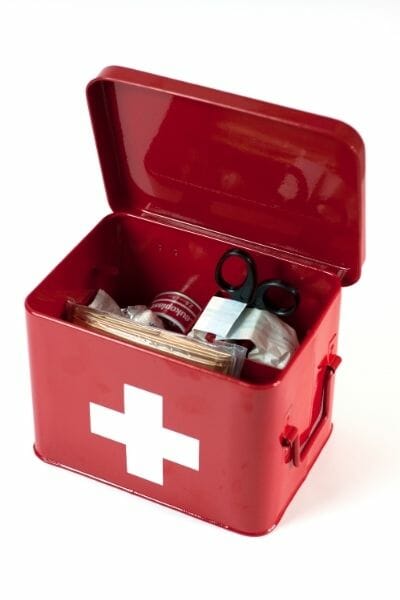Whether you’re creating a sensory garden for your dog or a catio for your cat, the first thing to consider is your pet’s health and safety. After all, the backyard is an extension of your pet’s safe space—your home, and there’s no reason for it to not be as perfect and secure as your living room or bed. So how does one create a beautiful and safe outdoor lifestyle for your pets—all while enriching their physical, mental, emotional, and social needs in a safe and enclosed setting? Read on!
With just a few of our tips and tricks, you can create a pet-friendly backyard that your dog or cat will always want to go back to. Here’s how to get started…
1 Choose the right plants for your backyard.
Before purchasing a plant to grow in your backyard, always do a quick toxicity check. ABC Life reports 10 common plants that are lethal to both cats and dogs. These are: cannabis, lilies, sago palms, ivy, philodendrons, rubber tree plants, aloe vera, Chinese evergreen, asparagus fern, and lantana. Aside from the aforementioned plants, common flowers that are also poisonous for both species include holly, tulip, oleander, azalea, daffodil, carnations, and chrysanthemum.
Pet Poison Helpline states that “only a small percentage of plants are truly dangerous and poisonous to your pet.” However, it’s better to be safe than sorry. Autumn crocus, cyclamen, kalanchoe, dieffenbachia, lily of the valley, and hyacinths are also included in Pet Poison Helpline’s most dangerous plants list. Just a bite of the root, leaf, branch, or petal could cause nausea, vomiting, diarrhea, and excessive drooling. If your pet does not receive immediate veterinary attention, some of these plants could cause your pet to fall into a coma and possibly die.

RenoGuide shares that “ferns, palms, catnip, lemongrass, and hibiscus are some of the most pet-friendly plants.” For pet owners living in Australia, try these outdoor plants:
- Groundcover: Baby’s tears, spider plant
- Flowers: African daisies, snapdragons, orchids, fuchsia, petunia
- Shrubs: Bottlebrush, camellia
- Trees: Crepe myrtle, magnolia
Flower Power adds that “most herbs and edible plants are also pet-friendly,” with cats having an affinity for catmint and cat grass.
TIP: For a comprehensive list of toxic and non-toxic plants for dogs and cats, check out ASPCA’s Animal Poison Control section.
2 Store dangerous tools and chemicals properly.
Dogs and cats are curious creatures, and if you’re not careful, they might accidentally topple over your fertilizer bag, sniff it, and taste it. Similarly, your pet can cut himself on sharp objects such as hedge shears and rake if these are just lying around. Before letting your dog or cat explore your backyard, make it a point to lock away all your essentials in a shed that your pet doesn’t have access to. Lawn chemicals, pesticides, and rat poison should be used conscientiously—if at all. Always search for organic pet-friendly alternatives.
3 Create a sturdy, enclosed barrier that will keep your pet safe and secure.
Most cats will be able to jump or climb over most traditional fences. That said, cat owners should make an extra effort to set up a fence that will be difficult for their pet to scale. Purr…fect Fence suggests using a vinyl privacy fence that’s difficult for cat’s claws to sink into, or estate-type fences with two-inch gaps to discourage climbing.
Aside from the type of material, installing a fence cat guard (with a lean-in fence top and screen overhang or a roller bar fence) will prevent your cat or dog from reaching the top of your fence and jumping over it. The Coyote Roller is a good example of a weatherproof ribbed roller that can stop animals from getting the foothold they need to climb over a fence. It is safe for pets and maintenance free.

Meanwhile, if your fence has a gap at the bottom, installing a metal fence barrier or an L-footer is a quick way to stop your cat from squeezing under the gap or your dog from digging the dirt and escaping your backyard.
4 Provide spaces for shade and shelter.
Dogs are known to get sunburn and suffer from heatstroke, so you should come up with a resting area within your backyard that allows your pets to stay cool. Both dogs and cats will appreciate this shaded area even more if you pile it with cosy materials such as blankets and pillows. Cat trees, scratching posts, and perching nooks would also make the space more appealing to your feline friends.
Also, provide clean drinking water in these shaded spots to encourage your pets to stay hydrated. Don’t leave food out in the open or these might attract other creatures and pests. Instead, go for treat-dispensing toys that will keep your pets entertained.
5 Add a fun water source.
Make things more interesting for your pooch by placing a water fountain, stream, pond, or even an inflatable baby pool where he can have a quick dunk! If you opt to create something more permanent, make sure there is a gentle sloping side or shallow set of steps that your dog can easily step out of.
6 Choose materials that will delight your pet’s paws.
If given the chance to choose landscaping materials, go for ones that your pet would find comfortable to step on. The Bark suggests textures such as concrete, brick, flagstone, pebbles, and smooth rocks, which more or less do not cling to fur and feet. Mulch (except cocoa mulch, which causes the same reactions as chocolate), small bark chips, and artificial turf (that does not heat up) can also be good alternatives to explore.
Through an interview with HGTV, Cassy Aoyagi of FormLA Landscaping advises, “Asphalt is hot and harsh on paws. Synthetic lawns hold heat as well. Gravel can get lodged between large dog paw pads, and small dogs may choke on it. Decomposed granite stays cool and is not a chewing hazard.”

7 Always keep your backyard clean.
Every time you let your pet out in your backyard, there’s a risk that he might contract various diseases. You and your pet may get infectious bacteria from damp leaves (blastomycosis), cat poop (toxoplasmosis), and dog poop (strains of E coli or salmonella, and even hookworm and roundworm eggs). Keep your backyard constantly clean to prevent bacteria and parasites from growing in it. Regularly trimming the hedges will also prevent injury to your pet, stopping thorns from poking their eyes or being lodged in their feet.
8 Have a spot devoted to play.
Give your pooch an open space where he can run like mad and expend all his excess energy. If you have the means and the area for it, why not build him a pet playground with various obstacles? For dogs who can’t stop digging, dedicate an area just for that purpose! Create a sandpit composed of fresh sand, then bury treats and chew toys for your pup to find.

9 Be extra.
Whether it’s a fence viewing window, a sitting rock, or different textured paths, your pet will appreciate all the extra features you set up to make the backyard pet-friendly. Make it easier for him to access the enclosure by setting up a pet door or flap, but always monitor the times he spends outdoors. No dog or cat should be left alone and unsupervised for long periods of time.
10 Protect your pet.
Always make sure your dog or cat is healthy and has up-to-date vaccinations before letting him explore the yard. Protect him from fleas and ticks by using pet-safe treatments such as tablets, collars, and spot-ons. Heartworm medication is also a must, especially if your place is notorious for mosquitoes.
Assemble a first aid kit for pet emergencies. Dogtime recommends having the following inside your pet first aid kit:
- Your pet’s paperwork: vaccination, medical records, and emergency phone numbers
- Hydrogen peroxide
- Antibiotic ointment
- Gauze, scissors, tape, rubber gloves
- Wet wipes or grooming wipes
- Towel or blanket
- Collapsible travel food and water bowls
- Water and small packages of food or treats
- Medication
- Your pet’s comfort item
- Extra leash, collar, and poop bags
- Flashlight
- A guide book for pet first aid

In conclusion
We hope you picked up inspiring ideas on how to turn your backyard into a pet-friendly one! By following the 10 tips and crafting a secure, outdoor haven for your pet, you help enrich your pet’s life in more ways than you can imagine.
For more informative articles, check out our other pet parenting guides!
Leave a comment
Your email address will not be published. All fields are required.